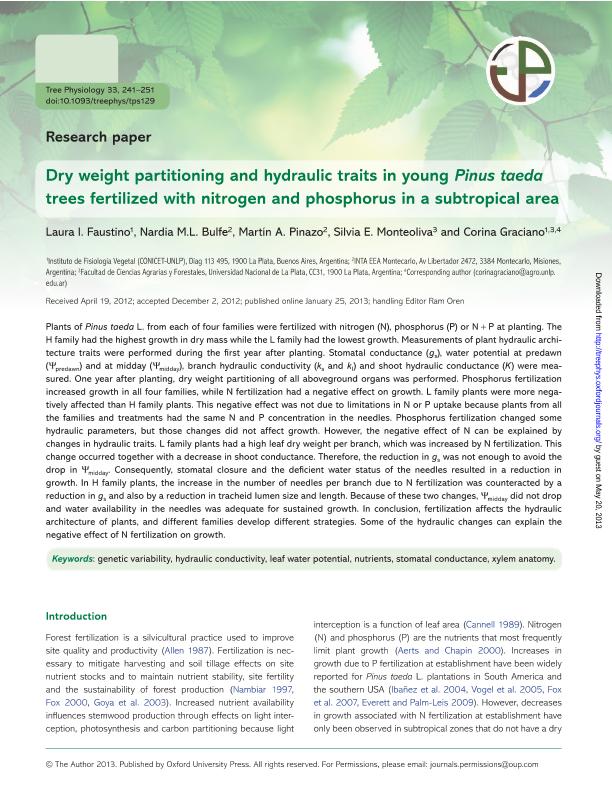Mostrar el registro sencillo del ítem
dc.contributor.author
Faustino, Laura Inés

dc.contributor.author
Bulfe, Nardia M. L.

dc.contributor.author
Pinazo, Martín Alcides

dc.contributor.author
Monteoliva, Silvia Estela

dc.contributor.author
Graciano, Corina

dc.date.available
2017-09-01T22:05:06Z
dc.date.issued
2013-02
dc.identifier.citation
Faustino, Laura Inés; Bulfe, Nardia M. L.; Pinazo, Martín Alcides; Monteoliva, Silvia Estela; Graciano, Corina; Dry weight partitioning and hydraulic traits in young Pinus taeda trees fertilized with nitrogen and phosphorus in a subtropical area; Oxford University Press; Tree Physiology; 33; 3; 2-2013; 241-251
dc.identifier.issn
0829-318X
dc.identifier.uri
http://hdl.handle.net/11336/23512
dc.description.abstract
Plants of Pinus taeda L. from each of four families were fertilized with nitrogen (N), phosphorus (P) or N + P at planting. The H family had the highest growth in dry mass while the L family had the lowest growth. Measurements of plant hydraulic architecture traits were performed during the first year after planting. Stomatal conductance (gs), water potential at predawn (Ψpredawn) and at midday (Ψmidday), branch hydraulic conductivity (ks and kl) and shoot hydraulic conductance (K) were measured. One year after planting, dry weight partitioning of all aboveground organs was performed. Phosphorus fertilization increased growth in all four families, while N fertilization had a negative effect on growth. L family plants were more negatively affected than H family plants. This negative effect was not due to limitations in N or P uptake because plants from all the families and treatments had the same N and P concentration in the needles. Phosphorus fertilization changed some hydraulic parameters, but those changes did not affect growth. However, the negative effect of N can be explained by changes in hydraulic traits. L family plants had a high leaf dry weight per branch, which was increased by N fertilization. This change occurred together with a decrease in shoot conductance. Therefore, the reduction in gs was not enough to avoid the drop in Ψmidday. Consequently, stomatal closure and the deficient water status of the needles resulted in a reduction in growth. In H family plants, the increase in the number of needles per branch due to N fertilization was counteracted by a reduction in gs and also by a reduction in tracheid lumen size and length. Because of these two changes, Ψmidday did not drop and water availability in the needles was adequate for sustained growth. In conclusion, fertilization affects the hydraulic architecture of plants, and different families develop different strategies. Some of the hydraulic changes can explain the negative effect of N fertilization on growth.
dc.format
application/pdf
dc.language.iso
eng
dc.publisher
Oxford University Press

dc.rights
info:eu-repo/semantics/openAccess
dc.rights.uri
https://creativecommons.org/licenses/by-nc-sa/2.5/ar/
dc.subject
Nutrients
dc.subject
Genetic Variability
dc.subject
Stomatal Conductance
dc.subject
Leaf Water Potential
dc.subject
Hydraulic Conductivity
dc.subject
Xylem Anatomy
dc.subject.classification
Otras Agricultura, Silvicultura y Pesca

dc.subject.classification
Agricultura, Silvicultura y Pesca

dc.subject.classification
CIENCIAS AGRÍCOLAS

dc.title
Dry weight partitioning and hydraulic traits in young Pinus taeda trees fertilized with nitrogen and phosphorus in a subtropical area
dc.type
info:eu-repo/semantics/article
dc.type
info:ar-repo/semantics/artículo
dc.type
info:eu-repo/semantics/publishedVersion
dc.date.updated
2017-08-07T16:38:52Z
dc.journal.volume
33
dc.journal.number
3
dc.journal.pagination
241-251
dc.journal.pais
Reino Unido

dc.journal.ciudad
Oxford
dc.description.fil
Fil: Faustino, Laura Inés. Consejo Nacional de Investigaciones Científicas y Técnicas. Centro Científico Tecnológico Conicet - La Plata. Instituto de Fisiología Vegetal. Universidad Nacional de La Plata. Facultad de Ciencias Naturales y Museo. Instituto de Fisiología Vegetal; Argentina
dc.description.fil
Fil: Bulfe, Nardia M. L.. Instituto Nacional de Tecnología Agropecuaria. Centro Regional Misiones. Estación Experimental Agropecuaria Montecarlo; Argentina
dc.description.fil
Fil: Pinazo, Martín Alcides. Instituto Nacional de Tecnología Agropecuaria. Centro Regional Misiones. Estación Experimental Agropecuaria Montecarlo; Argentina
dc.description.fil
Fil: Monteoliva, Silvia Estela. Universidad Nacional de La Plata. Facultad de Ciencias Agrarias y Forestales; Argentina. Consejo Nacional de Investigaciones Científicas y Técnicas; Argentina
dc.description.fil
Fil: Graciano, Corina. Consejo Nacional de Investigaciones Científicas y Técnicas. Centro Científico Tecnológico Conicet - La Plata. Instituto de Fisiología Vegetal. Universidad Nacional de La Plata. Facultad de Ciencias Naturales y Museo. Instituto de Fisiología Vegetal; Argentina. Universidad Nacional de La Plata. Facultad de Ciencias Agrarias y Forestales; Argentina
dc.journal.title
Tree Physiology

dc.relation.alternativeid
info:eu-repo/semantics/altIdentifier/doi/http://dx.doi.org/10.1093/treephys/tps129
dc.relation.alternativeid
info:eu-repo/semantics/altIdentifier/url/https://academic.oup.com/treephys/article-lookup/doi/10.1093/treephys/tps129
Archivos asociados
